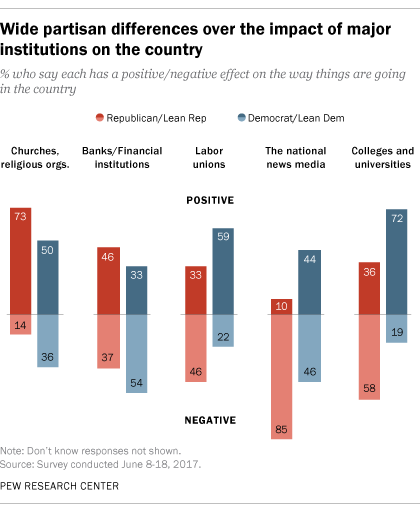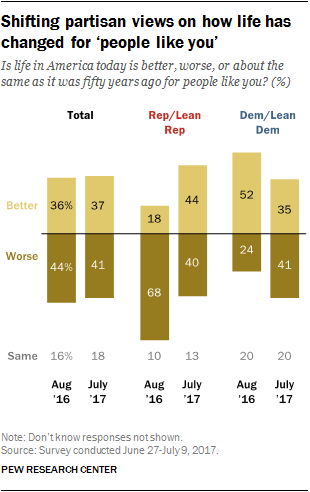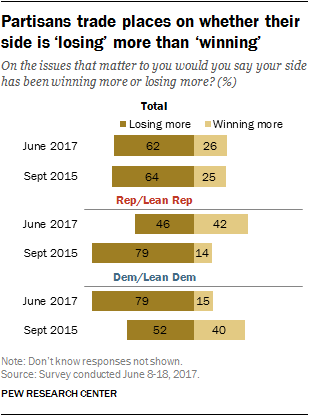Can the Democratic and Republican Party in Nevada stop the
downward slide in voter share? Looking at the just released voter registration
statistics for
July, 2017, it
does not look like it. The only bright spot for the Republican Party was in the
rural counties where they had a slight gain in voter share. Except for that,
both the major parties lost voter share across all tracked demographics. As has
been the trend, both Non-Partisan and the minor parties gained share.
The bad news does not stop there. For the second consecutive
month, the Democratic Party lost voter share in all 21 state senate districts
and all but one state assembly district. In the state’s congressional
districts, for the first time, both Non-Partisan and minor parties gained voter
share in all four districts.
State-Wide
|
Party
|
Change in # Voters
|
% Change
|
% Voter Share
|
Difference in Voter Share %
|
|
D
|
1,218
|
0.21
|
39.23
|
-0.08
|
|
R
|
1,574
|
0.32
|
33.10
|
-0.03
|
|
NP
|
1,823
|
0.59
|
21.04
|
0.04
|
|
Other
|
1,340
|
1.38
|
6.64
|
0.06
|
|
Total not D or R
|
|
|
27.68
|
0.10
|
Other includes IAP, Lib, and 5 parties without ballot
access.
Change is # voters: IAP +0.63%; Lib +0.96%; other 5 parties +4.46%
Clark County
|
Party
|
Change in # Voters
|
% Change
|
% Voter Share
|
Difference in Voter Share %
|
|
D
|
952
|
0.21
|
42.88
|
-0.08
|
|
R
|
888
|
0.30
|
28.81
|
-0.03
|
|
NP
|
1,189
|
0.52
|
21.95
|
0.03
|
|
Other
|
1,.192
|
1.83
|
6.36
|
0.09
|
|
Total not D or R
|
|
|
28.31
|
0.12
|
Other includes IAP, Lib, and 5 parties without ballot
access.
Change is # voters: IAP +0.71%; Lib +1.11%; other 5 parties +5.97%
Washoe County
|
Party
|
Change in # Voters
|
% Change
|
% Voter Share
|
Difference in Voter Share %
|
|
D
|
329
|
0.37
|
35.37
|
-0.08
|
|
R
|
526
|
0.56
|
37.58
|
-0.02
|
|
NP
|
534
|
1.08
|
19.90
|
0.09
|
|
Other
|
133
|
0.75
|
7.15
|
0.01
|
|
Total not D or R
|
|
|
27.05
|
0.10
|
Other includes IAP, Lib, and 5 parties without ballot
access.
Change is # voters: IAP +0.95%; Lib +0.89%; other 5 parties -0.03
Rural Counties
|
Party
|
Change in # Voters
|
% Change
|
% Voter Share
|
Difference in Voter Share %
|
|
D
|
-63
|
-0.14
|
24.01
|
-0.06
|
|
R
|
160
|
0.17
|
51.01
|
0.03
|
|
NP
|
100
|
0.31
|
17.50
|
0.03
|
|
Other
|
15
|
0.11
|
7.49
|
0.00
|
|
Total not D or R
|
|
|
24.99
|
0.03
|
Other includes IAP, Lib, and 5 parties without ballot
access.
Change is # voters: IAP +0.01%; Lib +0.36%; other 5 parties +0.64%
18 – 34 Year Old
|
Party
|
Change in # Voters
|
% Change
|
% Voter Share
|
Difference in Voter Share %
|
|
D
|
173
|
0.11
|
39.36
|
-0.09
|
|
R
|
237
|
0.27
|
22.50
|
-0.02
|
|
NP
|
456
|
0.39
|
29.83
|
0.02
|
|
Other
|
453
|
1.39
|
8.32
|
0.09
|
|
Total not D or R
|
|
|
38.15
|
0.11
|
Other includes IAP, Lib, and 5 parties without ballot
access.
Change is # voters: IAP +0.40%; Lib +1.10%; other 5 parties +3.86%
55+
|
Party
|
Change in # Voters
|
% Change
|
% Voter Share
|
Difference in Voter Share %
|
|
D
|
724
|
0.30
|
39.71
|
-0.06
|
|
R
|
1,063
|
0.43
|
40.51
|
-0.01
|
|
NP
|
602
|
0.69
|
14.49
|
0.03
|
|
Other
|
404
|
1.27
|
5.29
|
0.04
|
|
Total not D or R
|
|
|
19.78
|
0.07
|
Other includes IAP, Lib, and 5 parties without ballot
access.
Change is # voters: IAP +0.76%; Lib +0.94%; other 5 parties +4.82%
Major party loses also continue in congressional and
legislative districts.
Congressional Districts
|
Party
|
# Districts Lose Voter Share
|
# Districts Gain Voter Share
|
# Districts No Change
|
|
Democratic
|
4
|
0
|
0
|
|
Republican
|
4
|
0
|
0
|
|
Non-Partisan
|
0
|
4
|
0
|
|
Other
|
0
|
4
|
0
|
Both CD 1, CD 2, and CD 4 continue to show the number of
voters not affiliated with either major party is greater than or within 5% of
the number of voters registered to one of the major parties. Note that
Non-Partisan and minor parties gained voter share in all districts.
State Senate Districts
|
Party
|
# Districts Lose Voter Share
|
# Districts Gain Voter Share
|
# Districts No Change
|
|
Democratic
|
21
|
0
|
0
|
|
Republican
|
16
|
3
|
2
|
|
Non-Partisan
|
2
|
17
|
2
|
|
Other
|
0
|
21
|
0
|
In 15 districts (71.4%) and an increase of one over June,
the number of voters registered as Non-Partisan or the total number not affiliated
with either major party is greater than or within 5% of the number of voters
registered to one of the major parties. Note the Democratic Party lost voter
share in all districts for the second consecutive month. At the same time,
minor parties gained voter share in all districts.
State Assembly Districts
|
Party
|
# Districts Lose Voter Share
|
# Districts Gain Voter Share
|
# Districts No Change
|
|
Democratic
|
41
|
1
|
0
|
|
Republican
|
20
|
19
|
3
|
|
Non-Partisan
|
11
|
27
|
4
|
|
Other
|
7
|
34
|
1
|
Unchanged. In 31 districts (73.81%) the number of voters
registered as Non-Partisan or the total number not affiliated with either major
party is greater than or within 5% of the number of voters registered to one of
the major parties. This is unchanged from last month. For the second
consecutive month, the Democratic Party lost voter share in all but one
district.
Senate bill 103 this last session attempted to address this
trend. Senate Majority Leader Aaron Ford (D – Las Vegas) refused to give the
bill a hearing. Not addressing the problem will not make it go away.



